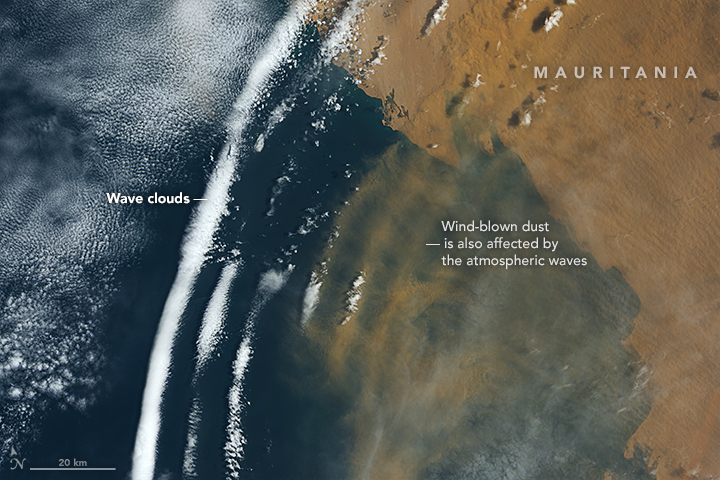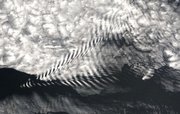Mesoscale waves
The mesoscale phenomena that are the easiest to describe are mesoscale waves. In the atmosphere various types of waves exists. The forcing mechanism differ among waves. Gravity waves, for instance, are forced by buoyancy, i.e. reduced gravity. The buoyancy forces acts as the restoring force on parcels that were displaced from hydrostatic equilibrium. This means conversion of potential and kinetic energy in the wave motion.
This unit covers gravity waves, inertial waves, inertio-gravity waves and Kelvin-Helmholtz waves and how to describe them by means of kinematics. It also covers the weather phenomena caused by mesoscale waves like lee clouds, and rotors, etc..

Learning goal
After this unit the student is able to
- Describe gravity waves, inertial-waves and inertio-gravity, Kelvin-Helmholtz waves in physical terms
- Recognize mesoscale waves in nature and satellite images and name them
- Explain their relevance in terms of weather and weather hazards
- Discuss the various types of waves that may occur in the atmosphere (graduate students)
Students’ Tasks
By Thursday 2359 AKST please
- Watch this video on the theoretical material related to gravity waves
- Watch this video on lenticularis clouds formed due to gravity waves lifting moist air to the level of dewpoint temperature
- Watch this video of gravity waves creating a tornado
- Watch this video of inertio-gravity waves
- Watch this video of Kelvin-Helmholtz waves
- Undergraduate students: Read chapters 6.9 to 6.9.5 (included) in Mölders and Kramm, Lectures of Meteorology
- Graduate students: Read the entire Chapter 3 in Lin, Mesoscale Dynamics, and chapter 6.9.5 in Mölders and Kramm, Lectures of Meteorology
- Watch this video of a solved problem
- Solve the tasks assigned at your class level in this unit 2 application sheet and send your scanned results to cmoelders@alaska.edu.
Supplemental material (optional)
Videos of worked problem
Read chapter 6.9 to 6.9.5 (included) in Mölders and Kramm, Lectures of Meteorology
Cool atmospheric gravity wave in the Atlantic Ocean on October 9, 2017
Another video on gravity waves
Gravity Waves Induced By Convection In Argentina
Kelvin-Helmholtz waves easy explanation
© 2020 Nicole Mölders | All rights reserved
